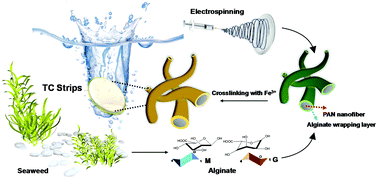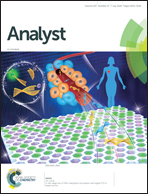Test strips based on iron(iii)-impregnated alginate/polyacrylonitrile nanofibers for naked eye screening of tetracycline†
Abstract
Tetracycline (TC) is an inexpensive broad-spectrum antibiotic used to treat infectious diseases and to promote growth in animals. However, driven by economic interest, abuse of TC poses a serious threat to human beings, and it remains a significant challenge to create easy-to-use TC colorimetric test strips for public use. Herein, we present a strategy to prepare free-standing, nanofibrous structured test strips with tortuous porous structure and large surface area by combining polyacrylonitrile nanofibrous membranes (PAN NMs), alginate, and Fe3+. In this approach, alginate was first functionalized on the PAN NMs and then, Fe3+ was assembled into the alginate to construct a TC-sensing surface. The resultant test strips exhibited the following integrated properties: fast sensing process (10 min), low naked eye detection limit (5 μg kg−1), excellent anti-interference ability, and satisfactory reusability. Furthermore, the TC concentration-dependent color change (yellow to maroon) was quantitatively visualized by an iPhone read-out hue parameter. All the findings indicate that this intriguing approach may pave the way for versatile designing of NMs to serve as a preventive treatment for the public.

- This article is part of the themed collection: Analyst Recent HOT articles


 Please wait while we load your content...
Please wait while we load your content...